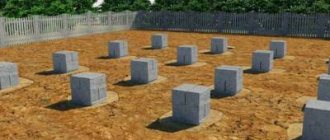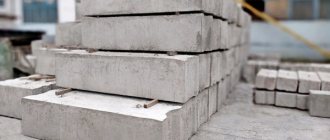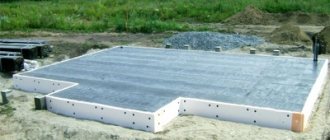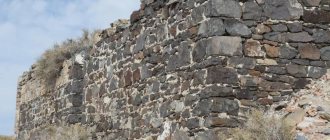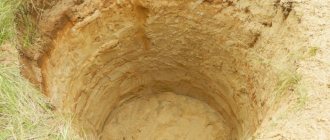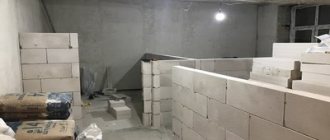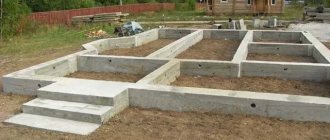A partition is an enclosing structure of small thickness that does not take the load from the overlying elements of the building. This concept should not be confused with full walls, load-bearing or non-load-bearing. A foundation for partitions will be required when constructing floors on the ground and strip foundations.
In this case, the partitions are mainly laid out of brick. The thickness of the structure is 12 cm. A brick fence with a thickness of 25 cm or more should be treated as a wall and full foundations should be provided for them.
There are several options for installing foundations for partitions in a house.
How to make a foundation for the internal partitions of a house
The foundation for partitions inside the house is created, as a rule, at the stage of foundation construction. But there are times when it is necessary to remodel and move interior walls. Depending on the material used, internal partitions can be heavy (for example, brick, block) or light (made of plasterboard, wood, OSB, plywood). Under the main walls, a more solid support is made that can withstand the load so that they do not deform or crack. At the same time, a foundation is not made for structures with insignificant weight.
Types of bases for partitions
The base for internal partitions is often created simultaneously with the support for load-bearing walls. But it happens that they cannot be built together, for example, due to the lack of a final plan for the rooms. It is also often necessary to redesign rooms in the house. Then you have to create a foundation for the interior walls.
Ready foundation for load-bearing and internal walls
For a private house, you can make a foundation of various types. The choice is determined by the following main factors:
- design load on the supporting structure;
- the type of soil at the construction site and its structure.
The most common types of bases are presented in the table below with the features of their use.
| № | Foundation type | Application area |
| 1 | pile | suitable for the construction of relatively light residential premises on frozen or heavily moistened soils or with weak bearing capacity, as well as when located close to the surface of the groundwater horizon |
| 2 | columnar | used for light structures |
| 3 | monolithic slab | It is practically advisable to use a slab foundation if it is necessary to erect a heavy, permanent building, especially when the soil of the construction site has a weak bearing capacity |
| 4 | tape | constructed with a large area of the building under construction, as well as a large load on the base |
Pile and column supports are used for buildings made of lightweight materials, for example, foam blocks, aerated concrete or frame structures. Such foundations are relatively inexpensive and are erected faster than slab and strip counterparts. But columnar supports are not used when the topography of the area being built is uneven or sloped, and the soil is subject to severe swelling or movement.
The monolithic slab ensures uniform distribution of the weight of the building over the entire area of the supporting structure. It can be built on any soil, and a wide variety of buildings can be erected on it. The slab is a ready-made basis for internal partitions. There is no need to strengthen anything. You just need to install the new walls correctly. But the high cost of a monolithic slab limits its use only to complex construction conditions.
The foundation tape is the best option in terms of the ratio of costs to structural reliability. This makes it popular and widespread in the construction of housing, as well as utility buildings. In each case, it is necessary to perform a preliminary calculation of the foundation in order to build it efficiently.
The need for a foundation under interior walls
The duration of operation is determined to a large extent by the reliability of the foundation structure. Construction time and costs are largely determined by the material used.
Laying reinforced concrete beams as supports
Whether a foundation is needed for interior walls depends on their weight:
- if you plan to build brickwork or build from various blocks, then you will need to make a solid foundation;
- when partitions are made from lightweight materials (plasterboard, plywood, OSB, chipboard), then the creation of a supporting structure for them is not required.
The construction of the foundation should be carried out taking into account a number of nuances:
- to extend the service life of the structure being created, it is waterproofed;
- the strongest foundation for interior partitions is obtained when it is securely connected to the foundation under the load-bearing walls: the best option is the simultaneous construction of supporting structures;
- the laying depth may be less than that of the main foundation.
Trench for foundation tape
Before construction, the weight of the partition being created is calculated in order to determine the parameters of the base. Determining the dimensions makes it possible to calculate the required amount of building materials.
Connecting the foundation structure into one whole will give maximum reliability and strength. On sandy types of soil, the laying depth is from 0.5 m. The wider the partition, the greater the similar support parameter should be. The amount of building material can be calculated either independently or using a special calculator on the Internet.
Marking for the foundation
To indicate the boundaries of the foundation, you must know exactly the parameters of the building. The width of the strip base should exceed the thickness of the walls by 10-20 cm; the width of the foundation under the load-bearing internal partitions corresponds to their thickness. The bottom of the trenches is usually located 20 cm below the soil freezing level, but this does not apply to shallow foundations.
Scheme of step-by-step foundation marking
For marking you will need:
- thin cord, a roll of twine or fishing line; wooden pegs; tape measure; square; plumb line.
The area is cleared of tall vegetation, large stones and anything that might interfere with the work are removed. Then the location of one of the corners of the facade is determined and a peg is driven into the ground.
Proper marking of strip foundations
To determine the remaining angles, precise measurements will be required:
- from the peg, measure the width of the facade and install the second beacon; use a plumb line to set the vertical of the first corner and pull a fishing line from it perpendicular to the line of the facade; use a square to determine the last corner of the building and drive the peg in again; connect the pegs with a stretched fishing line; measure both diagonals of the resulting perimeter and compare if the diagonals have different lengths, adjust the location of the beacons. Checking the correctness of the foundation markings
The outer perimeter of the marking is ready, now you need to make the inner one. To do this, on both sides of each peg, another peg is driven in at a distance of 40 cm. They must be located exactly on the marking line.
Twine is pulled between opposite pegs to create an internal perimeter. Next, all internal load-bearing walls are marked and beacons are installed in the same way. After this, it remains to determine the lowest marking point from which the depth of the trench will be measured.
Foundation construction technology
The foundation for interior partitions can be done either immediately, by constructing the foundation, or during the process of internal reconstruction of the housing. Construction will require the following tools:
- shovels for digging and excavating soil;
- level;
- tape measures, pegs and ropes;
- scrap;
- hammer drill.
The material selected for construction is purchased after the required quantity has been calculated. If you plan to pour concrete, you will need:
You can use ready-made concrete grades starting from M300. If the construction of partitions is carried out directly during the construction of the base, then the use of technology will speed up the work process. The construction of a monolithic strip foundation occurs according to the following algorithm:
- clear and prepare the land;
- make markings;
- they dig trenches, under the partitions inclusive;
- pour a sand cushion;
- install formwork;
- lay waterproofing on the bottom;
- install the reinforcement frame;
- pour the solution.
After the concrete has hardened, the panels are removed. Further construction begins after the monolith has reached the required strength (in about a month). The base should rise above the ground surface by at least 0.5 m.
Simultaneous construction of the entire foundation is the best option when everything is done in order. If redevelopment is necessary, it is less convenient to make the foundation, because you will need to dismantle the floor and remove the soil.
Excavation
The easiest way to dig trenches is with an excavator, but if this is not possible, you will have to use shovels. During the digging process, you must not go beyond the markings, and the walls of the trench should be constantly leveled vertically.
It is very important that the depth is the same throughout the entire perimeter and that the bottom is as flat as possible.
If the soil is too dense and difficult to yield, it is enough to go deeper by 40-50 cm. After this, holes are drilled for support pillars in the corners of the trenches and every 2 m on straight sections.
This method allows you to make a reliable, strong foundation at a lower cost, because drilling holes even in dense soil is much easier than digging a trench. In addition, less concrete and reinforcement for the frame will be required. The depth of the holes for the pillars should be 15-20 cm greater than the freezing level, which is approximately 1.2-1.5 taking into account the depth of the trench.
Building the foundation inside the house
When partitions are made of heavy materials (brick, cinder blocks), then a foundation is required.
Formwork with reinforcement cage for pouring tape
The construction process includes the following stages:
- the floor inside the building is dismantled;
- mark the location of the foundation trenches;
- dig recesses of the required depth (approximately 0.5 m) and width;
- cover the bottom with a sand cushion about 10 cm thick;
- install shields;
- lay waterproofing material;
- a reinforcement frame is installed inside, connecting it, for example, with anchors to the main foundation;
- pour concrete;
- The surface of the monolith is leveled, checking with a level.
After the supporting structure has gained strength, the construction of partitions begins. The width of the tape is determined by the dimensions of the material used. It should exceed the thickness of the interior walls by approximately 5 cm on each side.
Lightweight partitions can even be installed directly on the floor, securely fastening them to it, the ceiling and adjacent walls. This is done by creating recesses, using anchors or reinforcement.
After dismantling the floor, you can pour a monolithic slab, and then build partitions on it.
The entire process of building a foundation for interior partitions with your own hands is shown in the video below. The construction of a foundation structure designed to support interior partitions during redevelopment is necessary if you plan to use heavy material. The simplest option is to use technology similar to the construction of a strip foundation. In addition to concrete, various blocks can be used. Correct calculation is important so that the support can withstand the load and the partition does not deform.
Transom beams supported on external walls
This option can be called more suitable for non-professionals. There are fewer opportunities to disrupt technology here. The role of the foundation for interior partitions in this case is played by reinforced concrete beams thrown between the walls of the building.
Section and reinforcement
The cross-section of such a beam is taken to be 350x500 mm with a length of no more than 6 m. In this case, 350 mm is the width of the element, and 500 mm is the height. If the span is 2-3 m, the section of the beam can be reduced to 200x300 mm (the larger size is the height). Confusing width and height is prohibited. If the crossbar is installed incorrectly, its load-bearing capacity is significantly reduced.
If the span is more than 6 m, intermediate supports will be required. To do this, columnar foundations are made from monolithic concrete or factory-made foundation blocks.
Beams are reinforced using steel reinforcement class A400 or A500C. Four rods with a diameter of 10-12 mm are used as working longitudinal reinforcement. To allow the rods to work together, clamps made of reinforcement with a diameter of 8 mm are installed. The clamp spacing is on average 200 mm. When reinforcing, it is important to maintain a protective layer of concrete - 40 mm.
Leaning
The beams must rest on the walls by at least 200 mm. For this purpose, when constructing the base, special niches are provided. If the foundations are already completed, niches for installing crossbars are made with a hammer drill.
The niche is designed so that the top of the beam is located 10-15 cm below the finished floor level. Waterproofing material is placed under the support of the beam. This is especially true when there is contact between materials with different properties. For example, if the base is made of brick. Rolled types are used as waterproofing: roofing felt, linocrom, waterproofing, etc. Waterproofing is also needed between the concrete beam and the brick partition.
Important! When using this method, it is important not to forget about frost heaving of the soil. This phenomenon occurs when the soil is simultaneously exposed to cold and moisture. The base increases in volume and tries to raise the building.
Preventing damage
The fight against frost heaving is important for owners of areas with clay, loam or sandy loam. The surest way to avoid the effects of frost heaving on the foundations of partitions is to prevent the beams from contacting the ground. This is easy to do; you just need to lift the crossbar above the surface.
The recommended gap width is 10% of the soil freezing depth, but not less than 100-150 mm. The freezing depth is calculated using the formulas from SP 131.13330.2012. To simplify calculations, you can use special maps and tables that show values for different cities.
A layer of low-density foam can be placed between the transom and the ground. When pressure from the ground increases, this material will become a damping layer and prevent damage to beams and partitions.
The main problem that arises during the construction of building support structures is soil deformation. It is not so acute when building on coarse sand or coarse soil, but it is important to remember that a reliable foundation for partitions in the basement or on the first floor is the key to the absence of cracks and troubles. On the second and subsequent floors, such structures are installed directly on the floors.
Do I need to pour a foundation for partitions?
The need for a foundation for the internal partitions depends on the weight of the partitions themselves. Brick and aerated concrete block partitions require a strip base, and partitions made of gypsum plasterboard, chipboard or plywood can do without support.
Construction of the foundation involves a number of nuances:
- Mandatory waterproofing. It extends the service life of the building.
- The foundation will be stronger if it is connected to the basement part of the load-bearing walls. Ideally, this is a simultaneous construction with a load-bearing foundation.
- The depth of laying the foundation for interior partitions may be less than the height of the supporting structure.
Assembly of formwork and frame
Strip foundation formwork
The foundation walls must rise above the ground surface, so it is necessary to make strong formwork and install it on both sides of the trenches. The reinforcing frame is also an important element of the foundation, because it ensures the strength of the foundation and extends its service life.
At this stage of work you will need:
- construction level; plywood sheets or strong boards; self-tapping screws; plastic film; stapler; bars for spacers; reinforcement with a cross-section of 12 mm; knitting wire.
Laying reinforcement
Iron and steel elements are used as reinforcement for the base. The metal frame increases the strength of the structure.
Reinforcing elements are laid under the future foundation after the following stages:
- Drawing up and approval of the project;
- Territory preparation;
- Marking;
- Digging trenches;
- Laying the “pillow”;
- Laying waterproofing;
- Installation of formwork.
A layer of sand of about 15 cm is poured onto the bottom of the trench, and removable or permanent formwork is installed. The latter differs in that, in addition to the main load-bearing function, it provides additional insulation for the base.
Then the reinforcement is laid. The reinforcing elements must be firmly held in the prepared trench and connected to each other. If the internal foundation is installed after the external walls are erected, the reinforcement is attached to the base of the load-bearing walls with anchor bolts.
Pouring technology
A layer of gravel with sand is a kind of cushion on which the concrete solution is laid. A layer of waterproofing, such as polyethylene or roofing felt, is laid on top of it to extend the service life of the structure.
You should not prepare a large amount of cement at once, as it hardens quickly.
Filling is carried out in several stages:
- A layer of concrete (30-50 cm) is poured into the prepared trench with a cushion, reinforcement and formwork.
- Compact the material with a hand tamper to release air bubbles, which make the base less durable.
- Allow the layer to set (1-2 days) and continue working.
Using this technology, the foundation is poured to the required height.
Device and features
If aerated concrete partitions are installed during the renovation and redevelopment of apartments or houses, markings must first be applied. The line is upholstered around the entire perimeter: on the floor, ceiling, walls. The easiest way to do this is with a laser plane builder. If it doesn't exist, it's better to start with a stream:
- Mark a line on the ceiling (two points on opposite walls). A painting cord, painted with blue or some other dry dye, is pulled between them. With its help they beat off the line.
- The lines on the ceiling are transferred with a plumb line to the floor.
- Then the lines on the floor and ceiling are connected by drawing vertical lines along the walls. If everything is done correctly, they should be strictly vertical.
The next step in constructing aerated concrete partitions is waterproofing the base. The floor is cleaned of debris and dust, waterproofing roll material is laid (any: film, roofing felt, waterproofing material, etc.) or coated with bitumen mastics.
Vibration dampening strips
To reduce the possibility of mother-in-law formation and increase sound insulation characteristics, a vibration-absorbing strip is laid on top. These are materials with many small air bubbles:
- hard mineral wool - mineral wool cardboard;
- polystyrene foam of high density, but small thickness;
- soft fiberboard.
The first row of blocks is laid on this strip with glue. Glue thickness is 2-5 mm, consumption for a thickness of 1 mm is 30 kg/m3. Next, the construction of partitions occurs using the same technology as load-bearing walls. Read more about the technology of laying aerated concrete walls here.
On short spans - up to 3 meters - no reinforcement is done at all. On longer ones, a reinforcing polymer mesh, a perforated metal strip, as in the photo, etc. are laid.
Aerated concrete partitions can be reinforced if desired
Connecting to a wall
To ensure connection with adjacent walls at the masonry stage, flexible connections are placed in the seams - these are thin metal perforated plates or T-shaped anchors. They are installed in every 3rd row.
Connecting the wall and partition using a T-shaped anchor
If a gas silicate partition is installed in a building where such connections are not provided, they can be fixed to the wall by bending them in the shape of the letter “L”, inserting one part into the seam.
When using anchors, the connection with the wall is rigid, which in this case is not very good: a rigid rod due to vibrations (wind, for example) can destroy the adjacent adhesive and the body of the block. As a result, the abutment strength will be zero. When using flexible connections, all these phenomena will not affect the blocks so much. As a result, the bond strength will be higher.
Flexible connections in the seams; if there are none, the plates are simply screwed onto self-tapping screws
To prevent the formation of cracks in the corners, between the wall and the partition, a damper joint is made. This can be thin polystyrene foam, mineral wool, a special damper tape that is used when laying heated floors, and other materials. To prevent moisture from leaking through these seams, after laying they are treated with a steam- impermeable sealant.
Openings in gas silicate partitions
Since the partitions are not load-bearing, the load will not be transferred to them. Therefore, there is no need to lay standard reinforced concrete beams over the doors or make a full-fledged lintel, as in load-bearing walls. For a standard doorway of 60-80 cm, you can lay two corners that will serve as a support for the overlying blocks. Another thing is that the corner should protrude 30-50 cm beyond the opening. If the opening is wider, a channel may be required.
In the photo, two metal corners (on the right) are used to strengthen the opening of a standard door; a channel is walled up in the opening on the left, for which grooves are selected in the blocks.
If the opening is not wide, and only two blocks are joined in it, it is advisable to select them so that the seam is almost in the middle of the opening. This will give you a more stable opening. Although, when laying on corners or channels, this is not the table: the load-bearing capacity is more than enough.
Doorways in aerated concrete partitions
To prevent the metal from bending while the glue dries, the openings are reinforced. In narrow openings, it is enough to nail boards; in wide openings, a supporting structure resting on the floor may be required (put a column of blocks under the middle of the opening).
Another option for how to strengthen a doorway in aerated concrete partitions is to make a reinforced tape from reinforcement and glue/mortar. A flat board is stuffed strictly horizontally into the opening, nailing it to the walls. Sidewalls are nailed/screwed to the sides to hold the solution.
The solution is placed on top of the board, and three bars of class A-III reinforcement with a diameter of 12 mm are placed in it. Partition blocks are placed on top, as usual, making sure that the seams move. The formwork is removed after 3-4 days, when the cement “sets.”
Opening in a partition made of blocks
Last row - adjacent to the ceiling
Since floor slabs can bend under load, the height of the partition is calculated so that it does not reach the floor by 20 mm. If necessary, the blocks of the upper row are sawn. The resulting compensation gap can be sealed with damping material: the same mineral wool cardboard, for example. With this option, sounds from the upper floor will be heard less. An easier option is to moisten the seam with water and fill it with polyurethane foam.
Construction inside the house
Such a foundation is characterized by the complexity of preparatory work. If you need to separate a room in a house that has been in use for a long time, you will need to tear out the floors, rearrange the joists and the entire underground pie to prepare the space. It is better to make do with a partition made of lighter materials, for example, plasterboard.
For decent sound insulation, insulation is laid inside the structure, and the frame is attached with a special backing.
If only a “box” is built, there is soil inside the house, the following algorithm of work is possible:
- Marking;
- Digging trenches;
- Preparing the sand bed;
- Installation of waterproofing;
- Installation of formwork;
- Installation and bundling of reinforcement;
- Filling and leveling.
If there is a basement in the house, the task is somewhat simplified.
Laying waterproofing
To prevent groundwater from having access to the supporting system of the building and causing damage to the structure, waterproofing is used. To do this, you will need any liquid or roll material (mastic, roofing felt, resin, polyethylene, waterproofing, etc.).
It is usually more convenient to use rolled materials, but sometimes, on the contrary, liquid ones.
- We cut a piece of material in accordance with the length of the base and twice its width.
- Fold the material in half lengthwise.
- We lay the prepared substrate on top of the supporting structure and glue it with bitumen or resin.
The basement part of the internal foundation does not need external waterproofing.
Partitions on top of the waterproofing can be installed after the base has gained sufficient strength. This usually takes from 25 to 35 days.
Share this article with your friends on social media. networks!
Foundation for interior partitions
Foundation for internal partitions
One of the stages of building a house or any building is the construction of internal partitions. Depending on their purpose, these elements are made from lightweight building materials such as plywood or OSB board. But sometimes the internal space requires the installation of capital partitions. They are made from heavier materials such as bricks or blocks.
Aerated concrete partitions price for work
The cost of laying partitions starts from 400 rubles per square meter. But if the volume of work is large, and for example, you need to erect several partitions in one building, then the builders can make a discount. The fact is that a large volume of work is more profitable for builders, since they do not need to transport tools and materials to different sites several times, and thus they save their time, and time is money.
Is it necessary to make a foundation for interior walls?
The service life of houses largely depends on the foundation. But a high-quality, solid foundation requires significant costs. Therefore, first of all, the material for the manufacture of partitions is determined. Depending on this, they conclude whether it is necessary to build a foundation for the partitions:
- Chipboard, plywood or plasterboard are lightweight materials. Partitions made from them will have little weight. Therefore, no additional foundation is required for such walls.
- Brick and concrete walls, as well as interior walls made of block materials, require a solid foundation. Therefore, there is a need to build a foundation.
Foundation for interior walls
When building a foundation for interior walls, some nuances should be taken into account:
- A high-quality foundation can only be obtained by simultaneously pouring the foundation under the main walls and interior partitions. This will avoid warping of the walls during seasonal ground movements.
- Laying the foundation for interior walls is carried out at a shallower depth than the main foundation. However, when building a house on sandy soil, you need to dig a trench to a depth of at least 50 cm.
- A layer of waterproofing must be laid on the foundation under the partitions. This will slow down the process of destruction of the foundation due to moisture penetration.
Pouring concrete solution
Pouring concrete solution
The foundation must be poured with concrete mixture at one time.
If this process is extended, the solidity of the base will be broken, which will lead to the appearance of cracks and gradual erosion of the concrete. Now many people prefer to order ready-made concrete mortar directly from the factory, as this saves effort and time. If this is not possible, you will definitely need a concrete mixer, since it is very difficult to make such an amount of concrete by hand.
Pouring concrete solution
Before you start pouring, you need to calculate the consumption of concrete mixture for the foundation. Since the base consists of several tapes, it is first recommended to find out the volume of each segment, and then add everything together.
To find out the volume, the width of the tape is multiplied by its length and height. The total volume of the foundation is equal to the volume of the concrete solution. It is not worth ordering with a reserve, because in the calculations each corner of the perimeter was taken into account twice, which is precisely the necessary reserve.
The strength of the base largely depends on the brand of cement, as well as on the proportions of the components in the solution.
For the foundation of a residential building, it is optimal to use a mortar M300 or M400. To prepare it, you will need M500 cement, sand and fine crushed stone in a ratio of 1:3:4. The volume of water should be half that of all other components of the solution.
Pouring should be done in warm weather, since the cold reduces the strength of concrete and hardening occurs faster.
So, first prepare the solution:
- sift sand through a mesh; mix sand, crushed stone and cement; add water in small portions; mix the components thoroughly.
The finished solution has a uniform color and structure, a thick consistency, and when the shovel is turned over, it slowly slides down as a total mass, without separating into pieces.
When the concrete is ready, you can start pouring. The formwork must be filled in layers, distributing the solution around the perimeter with a thickness of about 20 cm. If you pour out the entire mixture at once, air voids will form inside, which sharply reduces the density of the foundation.
Pouring foundation formwork
After pouring the first layer, the solution is pierced in several places with a piece of reinforcement, and then compacted with a construction vibrator. If you don't have a vibrator, you can use a wooden tamper.
When the surface of the concrete is compacted and leveled, the second layer can be poured. They pierce the solution again, releasing air bubbles, then compact and level the surface. The last layer should be at the level of the stretched fishing line; The walls of the formwork are tapped with a hammer, and the surface is leveled with a trowel.
The finished foundation is covered with plastic film on top and opened only in dry, cloudy weather.
To avoid cracking, the top of the base is periodically moistened with water. The formwork can be dismantled 12-14 days after pouring, but it is recommended to carry out construction work no earlier than a month later. During this time, the foundation will become sufficiently strong and compacted, so the loads will not cause harm.
Construction of a foundation for interior walls
Foundation for heavy interior walls
A high-quality foundation for internal partitions is obtained if the foundation is poured simultaneously under all walls. However, in some cases it becomes necessary to erect partitions in an already built house. In this case, work on pouring the foundation for the internal walls is carried out in the following order:
- Inside the house, a hole up to 50 cm deep is dug across the entire area. The bottom of the hole is covered with sand and thoroughly compacted.
- Mark the trench. To make the partitions even and straight, you need to lay the foundation evenly. Therefore, at this stage it is recommended to use a building level.
- Now you can start digging a trench. The soil should be removed to a hard layer. The width of the trench depends on the material chosen for the manufacture of the partitions, plus a small margin of about 2 cm. This will prevent the partitions from settling and cracks appearing on them.
- For greater strength, it is necessary to connect the common foundation with the base intended for interior walls. To do this, holes are drilled in the foundation using a hammer drill. This is done in those places where the trench comes into contact with concrete. Reinforcement rods are installed in the resulting holes.
- The finished trenches are filled with concrete mixture.
- The upper part of the new base is carefully leveled and smoothed. On this basis, you can build a high-quality partition.
- Any construction work on such a basis can be carried out only after 3-4 weeks. During this time, the concrete solution will completely harden and the base will become stronger.
The foundation for the partitions can be made in another way: pouring the base of the floor with concrete mortar. Using this option requires significant material costs and careful soil preparation.
- First, remove the top layer of soil.
- In places where it is planned to erect partitions, trenches are dug to a depth of 50 cm.
- The entire area, including the bottom of the trench, is carefully compacted, generously wetting and adding crushed stone. A mesh of reinforcement is additionally laid in the trenches.
- The entire area is filled with concrete mortar in one step. This will ensure the connection between the main foundation and its branches.
Base for light walls between rooms
Lightweight versions of partitions can be erected on beams that rest on load-bearing walls. To do this, niches are left in the walls during the construction stage. The main condition is that the niche should be located 10 cm below the main floor.
If there are no niches in the wall, you can make them using a hammer drill.
Base for lightweight partitions
The length of the beam should not exceed 6 meters to avoid subsidence of the walls during operation. If the distance between the walls exceeds this parameter, then a support pillar must be used under the beam. Its installation is carried out only on dense soil.
High-quality foundation for interior partitions will prevent their deformation and destruction. Consequently, using the house for many years will not cause trouble or disappointment.
Reinforced concrete screed
This method is often used in the construction of multi-apartment residential buildings, administrative and public buildings. The performers are professional workers. For those who are building a house “for themselves,” this option is not recommended. If the technology is not followed, cracks will appear on the partitions.
The essence of the method is to install a widened cement screed at the point of support of the enclosing structure. If it is poured 80 mm across the entire width of the floor, then the thickness under the partition is 200-300 mm. In this case, the width of the reinforced section is taken to be 120-500 mm plus 90-200 mm on each side for the slopes. Ideally, the slope should be 45 degrees.
Reinforced screed.
Along the entire length of the partition, a mesh of steel reinforcement of class A400 (AIII) with a diameter of 8-10 mm with a cell size of 100-150 mm is placed in the concrete widening. If the thickness of the concrete layer is sufficiently large, instead of a mesh, it is possible to provide a reinforcement frame of 4 longitudinal rods and clamps with a pitch of 20-30 cm.
When laying the mesh, it is important to maintain a protective layer of concrete. It will protect the fittings from water and rust. The minimum value for foundations is 40 mm according to table 10.1 SP 63.13330.2012. To provide a protective layer, special plastic clips are used.
Important! The base for the cement screed must be carefully leveled and compacted. Typically, a bedding of sand or crushed stone 300-500 mm thick is used as a cushion, which is compacted layer by layer. If this point is not observed, cracks will certainly appear.
Waterproofing is provided between the concrete base and the brick partition. This can be a 50 mm thick cement joint, but it is better to use roofing felt or a similar material.
Experts recommend doing the work in this order:
- pouring a monolithic foundation;
- laying the cushion under the floors on the ground with careful layer-by-layer compaction (the thickness of one layer should not exceed 15-20 cm);
- pouring the subfloor taking into account reinforcements for partitions;
- erection of walls, ceilings and roofs of the building;
- laying partitions.
Types of foundations for load-bearing walls
Several types of foundations are used in the construction of buildings:
- For multi-storey buildings or houses with a huge area, tape is used;
- Columnar is suitable for lightweight construction;
- Buildings with high loads or additional plinths are placed on a monolithic base;
- Construction on frozen ground involves the pile type.
Small-area buildings made of lightweight materials (aerated concrete, foam blocks) are installed on a columnar base. This type is affordable and easy to assemble in a short time. This type should not be used if the construction site is uneven, bumpy and has slopes. The pile foundation is similar to the previous one, differing only in the depth of reinforcement and support elements. It is known that earth rocks are constantly moving and this type is not the best option. It is used when installing another option is impossible.
Monolithic foundations are used in the construction of any residential premises. This type of foundation is strong, stable, and the load can be evenly distributed over the entire area. The downside is its cost; it is so expensive that it is used in the most difficult construction cases.
The most popular ones are tape ones. They have the best price-quality ratio. Installation is possible on any type of soil, at different depths. This type is the most popular for the construction of residential buildings.
Materials for load-bearing partitions
The construction of various types of structures often involves not only the construction of external walls, but also the construction of internal partitions. The foundation for the partitions can be installed from bricks or blocks. They are used to reduce the load on the base and soil. Before you begin, you should choose the type of foundation for the entire house.
The service life of the room will directly depend on the quality of the foundation for load-bearing partitions. Often the cost of the foundation can be up to 15% of the total construction budget. It depends on the material that is used to create the internal walls of the building. Partitions made of lightweight materials do not need to be further strengthened at the bottom. But it is important to determine the size of the support and the material for its manufacture. Blocks require a wider base, as opposed to a brick internal partition.
When calculating the dimensions for a quality foundation, you should consider:
- how many floors are expected;
- load;
- load-bearing walls;
- soil mobility and purpose of the building.
Proper construction involves the simultaneous construction of the base of the external walls and partitions inside. Shifts in the earth will lead to distortion and even collapse.
The foundation for brick walls is made at a depth, as for an external wall. The construction of a heated and living space on loose soil involves laying a foundation to a depth of 0.5 m. The foundation should be equal to the width of the brickwork.
Rolls or liquid waterproofing agents are used as a base on any soil. This prevents distortion of the base, and in the future, the partition from moisture.
Thickness of aerated concrete partitions
On sale you can find aerated concrete blocks with a thickness of 75 to 375 mm. For non-load-bearing partitions, 100 mm and 125 mm blocks are usually used. The dimensions of the height and length of the blocks are standard - 600 mm by 200 mm, but there are also double gas blocks, the height of which is 400 mm. The larger format of the blocks significantly speeds up laying and reduces glue consumption.

